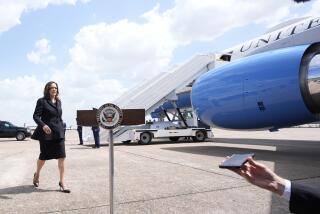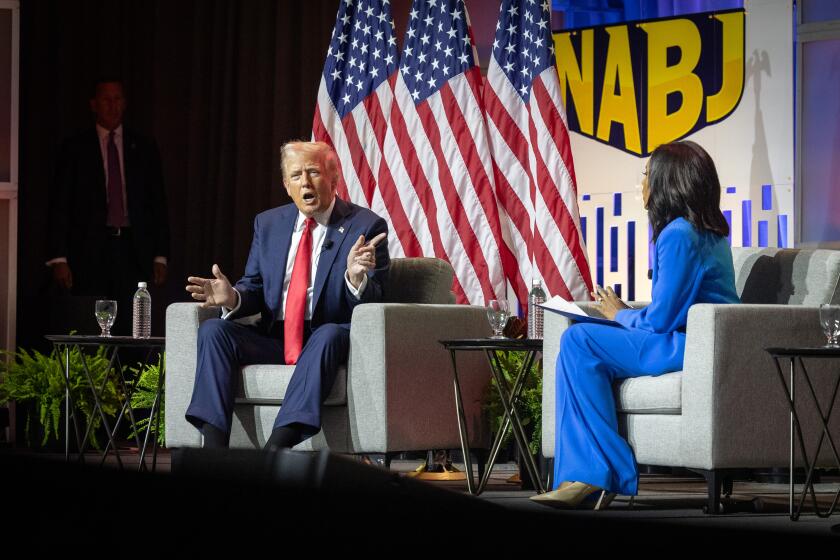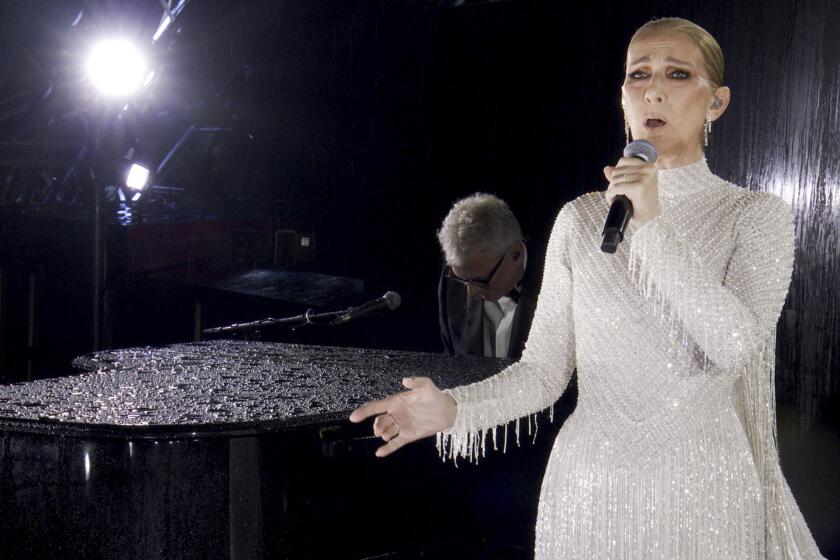Bush signs fence bill, pushes back
Legislation authorizing 700 miles of fencing along the southern U.S. border was signed into law by President Bush on Thursday in a ceremony that underscored Republican divisions over immigration policy and left unanswered whether the entire barrier would be built.
Flanked by House Majority Leader John A. Boehner (R-Ohio) and other Republicans who blocked his bid for a broader overhaul of immigration law, Bush used the opportunity to push back. “We have more to do,” the president said during the low-key event.
For the record:
12:00 a.m. Oct. 30, 2006 For The Record
Los Angeles Times Monday October 30, 2006 Home Edition Main News Part A Page 2 National Desk 1 inches; 37 words Type of Material: Correction
Border fence law: A map of the U.S.-Mexico border in Friday’s Section A, accompanying an article about President Bush’s signing of a bill authorizing fencing there, should have had a scale of 100 miles, not five miles.
Promises by GOP leaders to alter the law when Congress reconvenes after the Nov. 7 election -- in addition to a lack of funding set aside for the fence -- have cast doubt on how much of it ultimately will be built. Changes to the measure would probably include giving local governments and private property owners the chance to raise objections over the fencing’s location.
Bush did have words of praise for the fence bill, calling it “an important step toward immigration reform.” But he made clear that he opposed the enforcement-only position taken by the House and favored instead the approach embraced by the Senate: tougher border security and work-site enforcement combined with a guest worker program and a path to citizenship for some of the nation’s estimated 12 million illegal immigrants.
Bush said he looked forward to working with Congress on finding a “rational middle ground” between granting automatic citizenship to illegal immigrants and launching “a program of mass deportation.”
He also said, “We must reduce pressure on our border by creating a temporary worker plan.”
Some GOP leaders had pressed a reluctant White House for the signing ceremony so that as November’s election nears, Republicans could promote the fence bill as an accomplishment, party aides said.
“House and Senate Republicans ... will stop the hemorrhaging along our nation’s borders,” said a statement by Senate Majority Leader Bill Frist (R-Tenn.) and House Speaker J. Dennis Hastert (R-Ill.).
The House Republican leadership, in particular, views the fence not only as a needed security improvement but also as a powerful political statement that will win support for the party. Other Republicans, however, worry that it could cost the GOP support among Latino voters.
Mexican officials have harshly denounced the fence plan, and they continued their criticism Thursday.
“Walls don’t resolve anything; it’s a grave error,” said President-elect Felipe Calderon, who was traveling in Canada.
Calderon, due to be sworn in Dec. 1, added: “It would be more useful to the progress of our countries to build a kilometer of highways in Zacatecas or Michoacan than to build 10 kilometers of wall in Arizona.”
Mexican President Vicente Fox termed the measure “an embarrassment for the United States.” Commenting during a visit to Cancun, Fox said: “It’s an example of the inability of the United States to see the issue of immigration as one of shared responsibility.”
The fence’s advocates in Congress have countered that their first responsibility is to ensure the integrity of the U.S. border. There are currently about 90 miles of fencing along the southern border, including 14 miles in the San Diego area.
The new law contains detailed instructions for “at least two layers of reinforced fencing” around Tecate and Calexico, Calif., and across vast stretches of Arizona, New Mexico and Texas. But a letter written by Hastert and Frist to other congressional leaders when the measure cleared Congress on Sept. 29 detailed changes they wanted made to it when lawmakers returned to Washington in mid-November.
Hastert and Frist indicated they wanted to provide flexibility on where the fencing should go and on whether parts of it would take a physical or virtual form -- potentially using sensors, cameras and unmanned aerial vehicles in place of reinforced metal.
Their letter called for requiring the Department of Homeland Security to erect fencing in areas of frequent illegal entry, but also for giving the agency the option “to use alternative physical infrastructure and technology when fencing is ineffective or impractical.”
Also, Hastert and Frist want to require agency officials to consult with state and local governments, including Native American tribes, on the exact placement of fencing and other infrastructure, such as vehicle barriers.
Money poses another potential problem for the fencing. Cost estimates range from $3 million to $10 million per mile, for a total price tag of at least $2.1 billion -- and perhaps much higher -- before maintenance costs. The bill Bush signed, while authorizing the fencing, includes no money for it.
A separate budget measure for the Homeland Security Department provides $1.2 billion for border security that Republicans have referred to as the “first installment” for the fencing. But that money can be allocated as Homeland Security Secretary Michael Chertoff sees fit.
Agency officials have told Congress they would prefer 300 to 400 miles of fencing in areas where they believe it would be effective, and latitude to employ other security methods elsewhere.
“In urban areas, we’ve found that fencing is very effective; but in rural areas, sensors and other technology are more effective,” said Homeland Security spokesman Russ Knocke.
The new law has encountered resistance in parts of the Southwest: Opponents include the Texas Border Sheriffs’ Assn. and the city of El Paso.
Maria Luisa O’Connell, president of the Phoenix-based Border Trade Alliance, expressed concerns Thursday about the economic impact of more border fencing.
Mexicans who cross the border legally to shop in the U.S. “are seeing the fence as a sign that we don’t want anyone to come in,” said O’Connell, whose nonpartisan group works to stimulate cross-border commerce. “You want to have security, but you need a balance of economic security.”
Many Democratic lawmakers have expressed skepticism about the effectiveness of more fencing in significantly reducing illegal immigration. They also said Thursday’s bill signing spotlighted the GOP’s failure to reach a consensus on other immigration-related issues.
“The president and this Congress had a historic opportunity to pass a tough but fair immigration reform plan this year, but instead that chance was squandered,” said Sen. Edward M. Kennedy (D-Mass.).
The bill mandates that Homeland Security establish “operational control” of the border in 18 months, although it does not precisely define that term. It also calls for the agency to study potential improvements to the Canadian border.
Times staff writer Hector Tobar in Mexico City contributed to this report.
*
(BEGIN TEXT OF INFOBOX)
Back story
The fence bill that became law Thursday is the most tangible result of a public debate that sparked large protests in several U.S. cities and dominated much of this year’s congressional session.
The House passed a bill in December with a provision that would have made illegal immigration a felony. Strong opposition to that provision among Latinos helped attract an estimated 1 million people to a rally in downtown Los Angeles in early March; similar demonstrations occurred elsewhere.
In mid-May, President Bush took center stage with a prime-time speech calling for a path to U.S. citizenship for many illegal immigrants and a guest worker program.
The Senate passed a bill following that approach. But House Republican leaders expressed little interest in it. Congress settled on passing the fence bill in late September. The House approved it 283 to 138; the Senate vote was 80 to 19.
Source: Times research
More to Read
Get the L.A. Times Politics newsletter
Deeply reported insights into legislation, politics and policy from Sacramento, Washington and beyond. In your inbox three times per week.
You may occasionally receive promotional content from the Los Angeles Times.









